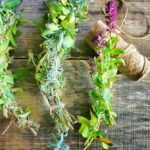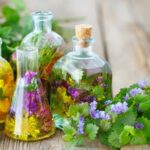Essential oils have always been some people’s go-to remedy, but they’ve really increased in popularity over the last several years. There are some great essential oil options on the market, but if you’re new to these plant-based tools, you might be wondering how to use essential oils properly.
Are essential oils just a way to make your house smell good? Do you put them on your skin? What about using them in your diet?
Here in our beginner’s guide to essential oils, we’ll go over the history and uses of these great earth medicines. We’ll also explore how you can get started using essential oils and the best essential oils for beginners.
What are Essential Oils?
If you’re wondering how to use essential oils, it helps to first understand what essential oils are. These alternative medicines come from plant extracts. The oils are used for aromatherapy and certain topical applications to support wellness.
Plants contain natural oils. These oils often contain scents and flavors (sometimes described as the “essence,” where essential oils get their name). The essence of chemical compounds is extracted from various plants through a distillation process using pressure, steam, or water. These extracts are highly concentrated.
The plant essence is sometimes added to a neutral carrier oil, depending on the purity and makeup of the oil. Most high-quality oils should be 100% pure, meaning there were no pesticides or other compounds used in growing or production, and they contain only the plant extract.
From a chemical perspective, essential oils are primarily made up of terpenes, which are the compounds that give plants their scent. Essential oils also contain aldehydes, phenols, esters, plant alcohols, and fatty acids. Essential oils contain nitrogen and sulfur-based compounds as well.
The theory behind essential oils is that the plant essence is highly concentrated and thus offers more effective properties of the plant. For example, if a plant has antimicrobial properties, the essential oil extracted from that plant will also have those properties in a high concentration. Scientists are still researching the benefits of many plants, and new insights come to light often.
Aromatherapists believe that by breathing in the aromas of essential oils, you may elicit a physical response. Our sense of smell is connected to our emotions and memories—the limbic system in our brains. By using essential oils, aromatherapists theorize we can regulate our emotional responses to stress, anxiety, and other stimuli and bring on a soothing effect.
There is also a long history of essential oils used topically and even orally. It’s important to work with an expert practitioner before taking essential oils orally because some can be dangerous and irritating to the throat, mouth, and respiratory tract. It’s also important to use caution when applying essential oils topically to the skin. Until you are familiar with your body’s response, dilute the oil with a neutral carrier like fractionated coconut oil or grapeseed oil.
The History of Essential Oils
Plant-based medicine is almost as old as humankind. Ancient people on every continent turned to plants for their healing properties, nutrition, vitamins, and flavor. Essential oils originated in Persia, Egypt, and India, eventually moving to Rome, Greece, and other countries throughout Asia. Scented oils were used as perfumes and to treat a variety of illnesses.
Ancient, scented oils were made by steeping leaves and flowers in oil. Alternatively, the plants were crushed, dried, or mashed together to create a topical poultice. In Africa, people often burned or crushed plants using them as incense or snuff to release medicinal qualities. Eventually, the practice of distillation was invented in Arabia, allowing people to extract the essential oils from plants.
Essential oils were distilled during the Middle Ages in Europe. Medieval medicinal practitioners used many plant extracts for health and wellness applications. Alchemists commonly sought out different applications for essential oils extracted from various leaves, herbs, roots, bulbs, flowers, resin, and wood.
The spice trade between India, China, and Europe increased access to plant-based products. Spices like cardamom and coriander were distilled, and essential oils were often extracted for use in pharmaceuticals and fragrances. Many of these essential oils were explored as food flavorings as well as medicinal tools.
Essential oils came with settlers to the new United States. During the 19th Century, many practitioners used earth medicine to solve a variety of medical issues. Indigenous peoples of the Americas had long used plants for health and wellness, and many of the new world plants became popular for health use.
With the advent of the pharmaceutical industry, organic and synthetic compounds were mixed in laboratories to create what we know as modern medicine. Yet, many of these compounds are still derived from plants and their chemical components. For example, aspirin comes from acetylsalicylic acid, derived from willow bark. Although pharmaceuticals are created in a lab, they still contain natural components and chemicals that harken back to humankind’s first medicine.
Choosing the Best Essential Oils
If you’re interested in learning how to use essential oils, the vast selection of oils on the market can quickly become overwhelming. Many companies make what they claim to be the best essential oils, and it’s hard to know what to choose.
One important note to remember is that essential oils and aromatherapy are considered alternative medicines, and the FDA or other quality-control overseers don’t regulate them—so claims like “100% natural oil” may or may not be meaningful. Even oils that claim to be therapeutic grade make a marketing claim that isn’t certified.
If you want to choose the best essential oils, it’s important that you look for oils from brands you trust. From my experience with the company, I sincerely trust Melaleuca and know that they have a good variety of high-quality yet affordable essential oils made in the USA.
Be sure to research and choose a reputable brand, especially if you plan to use essential oils topically or orally. Even if you only plan to use essential oils for aromatherapy purposes, you’ll want to ensure they’re free of synthetic ingredients and dangerous additives. Watch for ingredients like “natural fragrance,” which is very unspecific and could mean many different additives.
What are the Best Essential Oils for Beginners?
When you’re ready to start using essential oils, you might wonder which ones you should purchase first. There are many options on the market, and even affordable essential oils can add up quickly. In this beginners’ guide to essential oils, I wanted to give you a nice list to start.
The Best Essential Oils for Beginners:
- Lavender: Good for skin, stress, and relaxation.
- Tea Tree: Antimicrobial, cleansing.
- Peppermint: Energizing, helps open sinus passages, calms digestive issues.
- Lemon: Antimicrobial, degreaser, mood-lifting.
- Wild Orange: Energizing, solvent, antimicrobial.
- Frankincense: Balancing, soothes insect bites and stings, antimicrobial.
- Clove: Soothes tooth pain, antibacterial, helps with digestion.
- Clary Sage: Good for stress, calming to digestion, elevating.
- Rosemary: Anti-inflammatory, soothes joint and muscle pain.
If you haven’t used oils topically before, a carrier oil like fractionated coconut oil can help to dilute the oils and make them safe for the skin. Always test them before using them too much to ensure you don’t have an adverse reaction.
Are Essential Oil Blends as Effective as Single Note Oils?
Many people start testing essential oils and discover the great blends that are out there on the market. There’s something to using the blends (besides the fact that they often smell fantastic). Aromatherapists believe that certain synergistic blends can increase the potency and effectiveness of certain oils.
The theory behind why certain oils work together goes back to their chemical makeup. When certain properties mix together, they boost the effectiveness of each oil. Now, keep in mind that not all oils have a synergistic effect when blended. Some may even work against each other. Most blends you’ll find on the market—mixed by professional aromatherapists—are created to boost the synergy (not simply to smell amazing).
For example, mixing lavender and tea tree oil can boost the antifungal and antibacterial properties of the oils. Other oils, when blended, can become more effective anti-inflammatories, sleep aids, or sedatives.
While you can use single note oils to create blends suited to your taste and preferences, synergistic essential oil blends often contain a specific ratio and carefully tuned mix to create a particular effect. So while single-note oils are very effective, some of the blends can be an excellent investment because they may combine the effective powers of several different oils.
How to Use Essential Oils for the Best Results
So now that you’ve explored this beginner’s guide to essential oils, you may be wondering how to use essential oils in your day-to-day life. One of the most straightforward ways is to diffuse oils using an aromatherapy diffuser. These little devices create cold steam that dissipates into the air in your home, creating a pleasant effect and letting you reap the benefits of essential oils.
But if you’re not ready to invest in a diffuser yet, you can also enjoy the effects of essential oils by sprinkling a few drops in the palm of your hands and then inhaling deeply to enjoy the scent. Aromatherapy triggers powerful scent memories and reactions in your mind and body and can help you induce a calming, energizing, relaxing, or mood-boosting effect.
Sprinkle a few drops of essential oil into your bathwater. Add a few drops to simmering water on the stove. If you want to experiment with topical oil use, you can mix essential oils with carriers like grapeseed oil or fractionated coconut oil and then apply it to muscles or joints as needed.
One of my favorite ways to use essential oils is to add a few drops to a special necklace that I wear around my neck. The oils aren’t strong or overpowering, but the necklace allows you to gently enjoy the benefits of aromatherapy all day long. You can purchase the necklace in my Shopify store.
However you decide to experiment with essential oils, I hope you’ll find them helpful to your sense of wellness. Using essential oils in your daily life can help you feel energized, healthier, and less stressed. So give them a try today and let me know your experience in the comments!
For more on essential oils, don’t miss:








Leave A Reply!